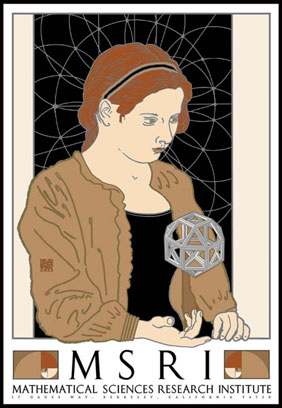
Click on image for detail
(255) MSRI Mathematical Sciences Research Institute:
Edition of 1306 of which 176 copies are signed 1-176, 29 copies are signed A-Bb as artist’s proofs. Three sets of progressives.
May 9, 2022
17” x 24”, 9 Colors
Paper: Domtar Cougar cover smooth white 100lb.
Inspiration: 1505 portrait of Luca de Pacioli by Jacopo de' Barbari (1460/70-before 1516)
Model: Lucrezia di Baccio del Fede del Sarto (1490 - c. 1570)
Hands: Amaya Dorman Mackenzie
Heptadecagon: After Carl Frederich Gauss (1777 - 1855)
Rhombicuboctahedron: After Leonardo da Vinci (1452 - 1519)
Golden Ratio: After Leonardo Fibonacci (c. 1170 - c. 1250)
Client: MSRI
1-125: Saint Hieronymus Press
126 - 176: MSRI
Progressives: MSRI
A-Aa: Artist’s own use
Dedication copy: Amaya Dorman Mackenzie
“We could never know the geometric triangle through the one we see traced on paper if our mind had not had the idea of it elsewhere.” —René Descartes (French, 1595 - 1650)
Geometrical shapes, such as the circle, triangle, square and rectangle, seem to fascinate humans and, near as can be determined, no other animal. Of course, every time we beat our chests and boast that we do something-or-other that other animals don’t, some other animal turns out to have been doing it all along. Language and tool use are certainly not ours alone. A sense of rhythm, thought until Snowball the cockatoo danced in perfect time to popular tunes, is the most recent “only humans” barrier to fall. Pufferfish and bowerbirds pitch woo with elaborate constructions. Art is all about attracting a mate, and pretty much every animal has got that part down.
But so far, the featherless biped that is us seems to display a built-in fascination with geometry that other animals do not share. In a study conducted in 2021, humans were shown six quadrilaterals and asked to pick the one that was unlike the others. Regardless of culture or education, none of them had any trouble.
Baboons mastered the odd-man-out test when presented with non-geometric images — picking out an apple, say, among five slices of watermelon. But when presented with regular polygons, their understanding completely failed. The experimenters conjecture that other animals have no understanding of, nor any need for, right angles, but this is far from certain. They may have been asking the wrong question, or the right question the wrong way but, in any event, we seem to be on our own, at least as far as geometry is concerned.
After simple counting, which many animals and even plants can do, arithmetic, which includes addition, subtraction, multiplication and division—all of which can be performed without using numbers, as with an abacus—the next step is geometry, which also can be performed without numbers.
Numbers, per se, appear rather abruptly around 4000BC in the Tigris and Euphrates river valley. People instinctively can recognize things in sets of three. More than three, you need to make notches in a stick or piles of pebbles: one notch or pebble for each thing counted. This works fine until you get cities, organized religion, roads and taxes. And this is just about when “IIIII III” turns into “8.” Eight cows, eight days, eight people—but eight has to be attached to something in order to make sense.
It took quite a while to separate “8” from the things it counts, and allow it to stand on its own as a pure abstraction. In 1202 the Italian Leonardo Fibonacci introduced the Hindu-Arabic numerals and the concept of zero to a European audience.
In 1543, Nicholas Copernicus turned the universe inside-out and, defying the plain evidence of our senses, removed Man from the center of the universe and placed him more toward the periphery of God’s attentions. There we remained until, in 1924, Edwin Powell Hubble relegated mankind to a mere speck in an infinitely immense universe by showing us that, once again, our eyes are not to be trusted.
And we’re just getting started.